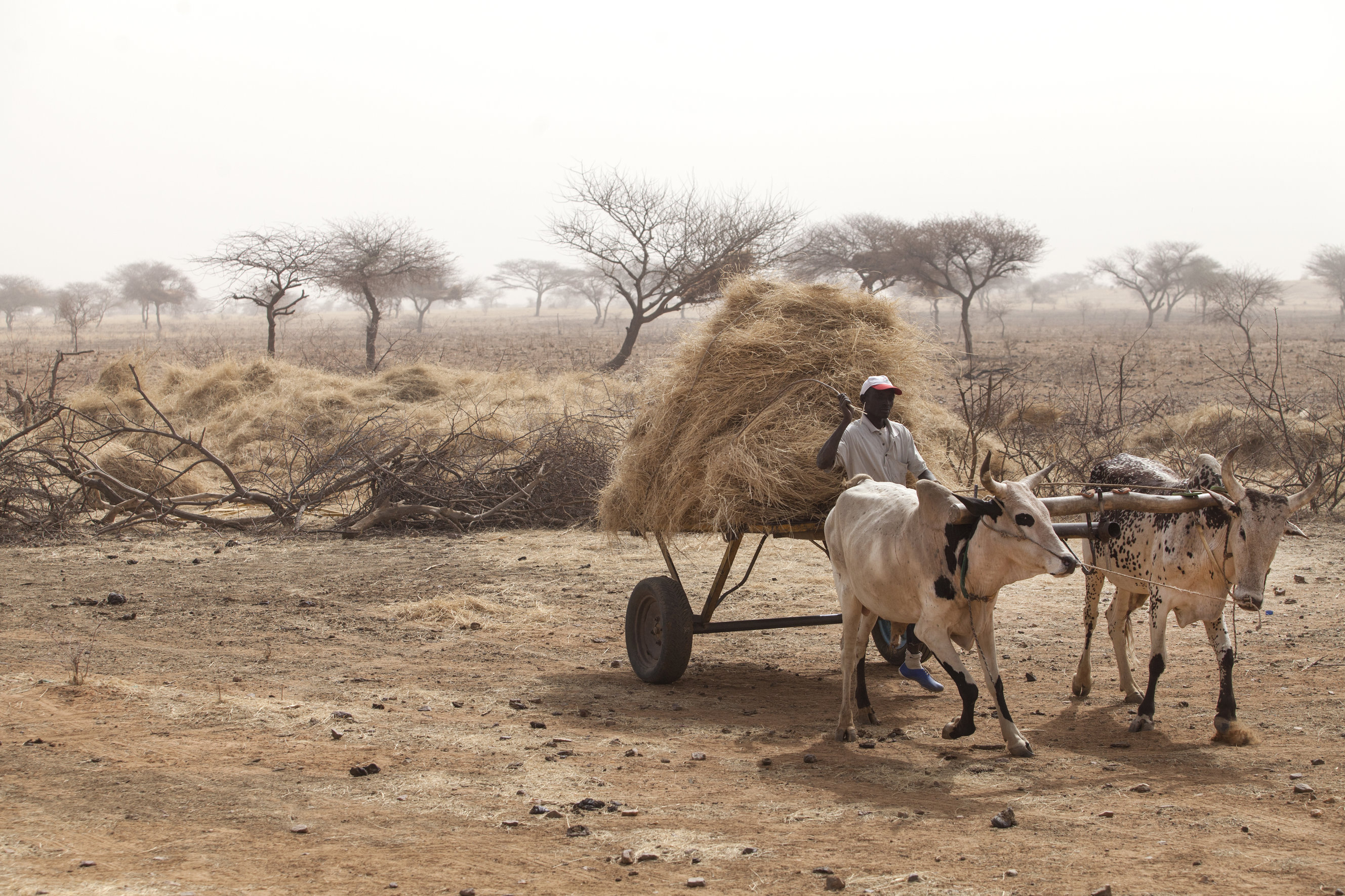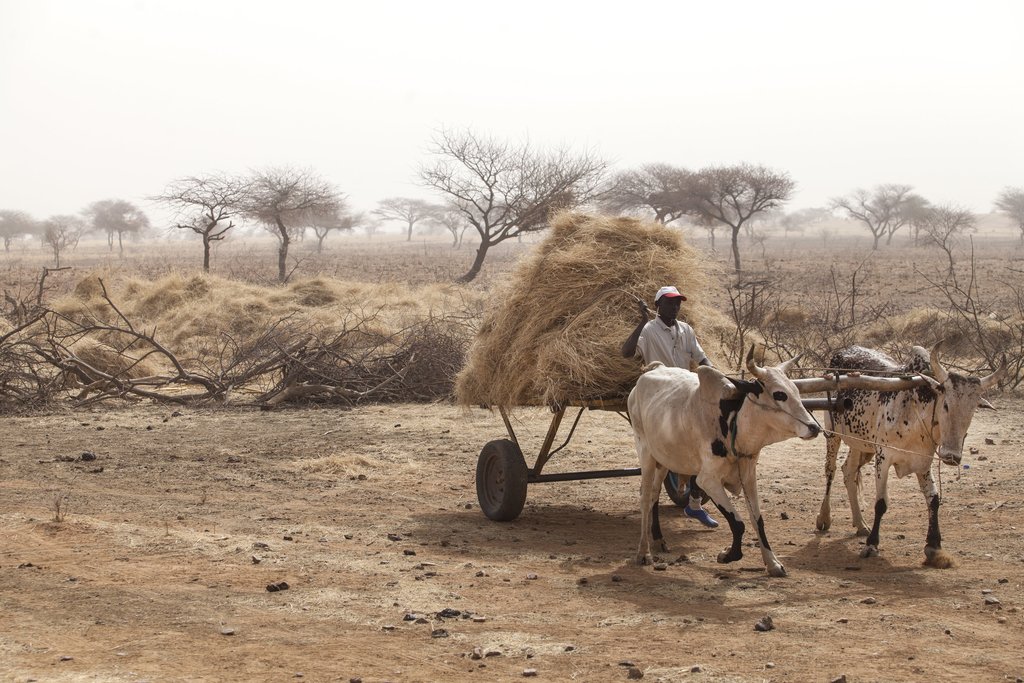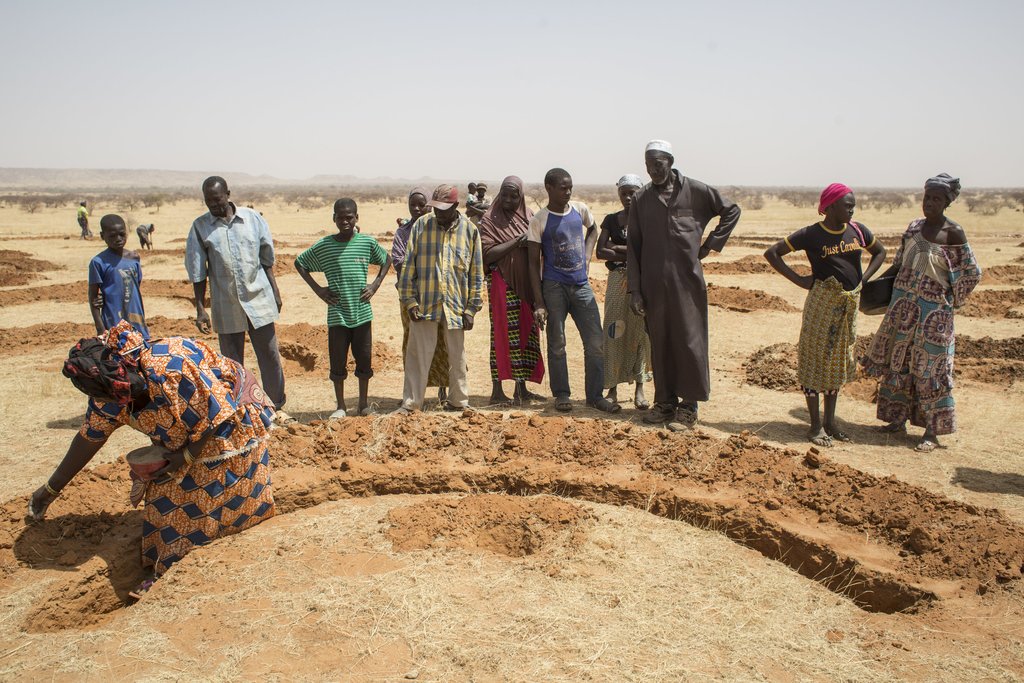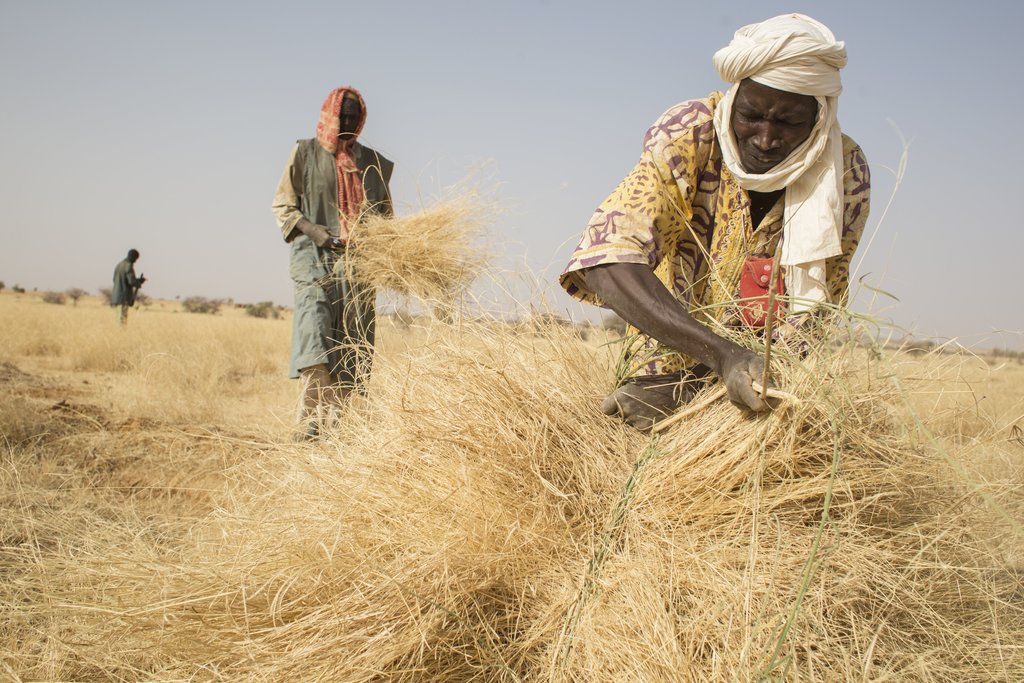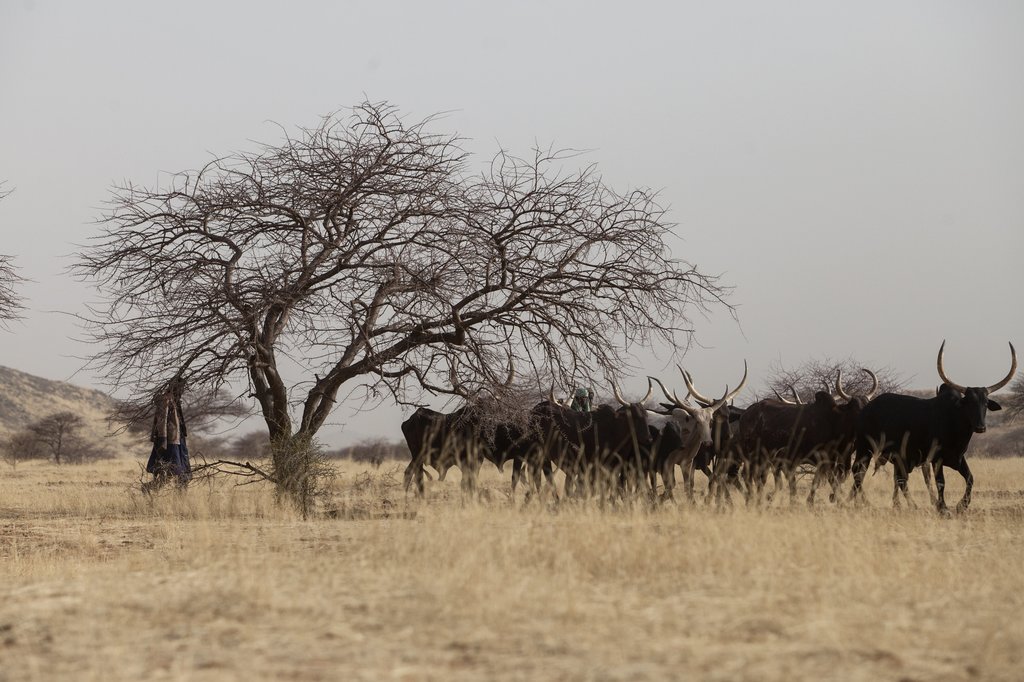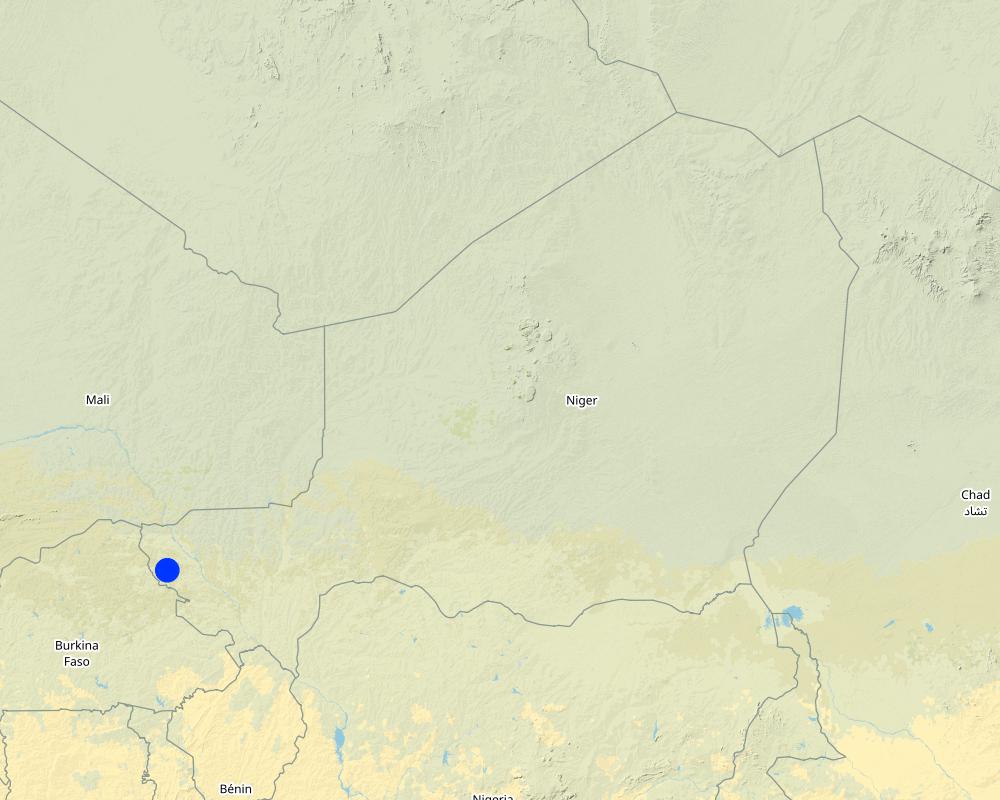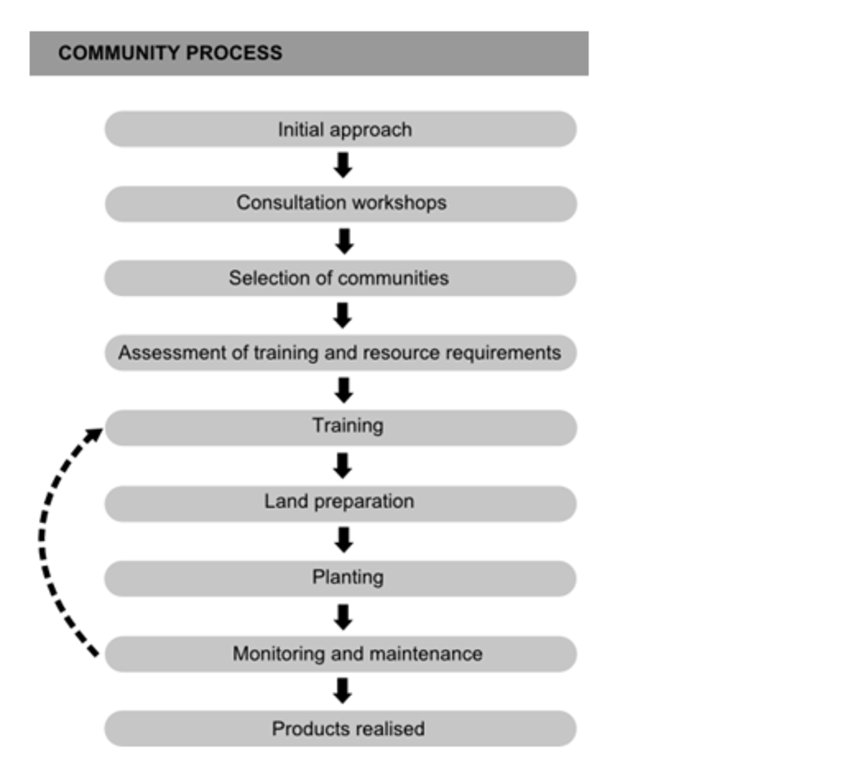Community participation in large-scale land restoration for Africa’s Great Green Wall programme [Níger]
- Creación:
- Actualización:
- Compilador: Vivian Onyango
- Editores: Moctar Sacande, Vivian Onyango
- Revisores: Donia Mühlematter, Simone Verzandvoort, Rima Mekdaschi Studer, Joana Eichenberger
approaches_2909 - Níger
- Resumen completo en PDF
- Resumen completo en PDF para imprimir
- Resumen completo en el navegador
- Resumen completo (sin formato)
- Community participation in large-scale land restoration for Africa’s Great Green Wall programme: 2 de noviembre de 2021 (inactive)
- Community participation in large-scale land restoration for Africa’s Great Green Wall programme: 4 de julio de 2018 (inactive)
- Community participation in large-scale land restoration for Africa’s Great Green Wall programme : 13 de mayo de 2018 (inactive)
- Community participation in large-scale land restoration for Africa’s Great Green Wall programme : 26 de abril de 2018 (inactive)
- Community participation in large-scale land restoration for Africa‘s Great Green Wall programme in Niger.: 24 de abril de 2018 (inactive)
- Community participation in large-scale land restoration for Africa’s Great Green Wall programme: 21 de agosto de 2024 (public)
Visualizar secciones
Expandir todo Colapsar todos1. Información general
1.2 Detalles de contacto de las personas de referencia e instituciones involucradas en la evaluación y la documentación del Enfoque
Especialista MST:
Sacande Moctar
moctar.sacande@fao.org
Forestry Policy and Resources Division (FOA)
Italia
Nombre del proyecto que facilitó la documentación/ evaluación del Enfoque (si fuera relevante)
FAO-Action Against DesertificationNombre del proyecto que facilitó la documentación/ evaluación del Enfoque (si fuera relevante)
Book project: Guidelines to Rangeland Management in Sub-Saharan Africa (Rangeland Management)Nombre de la(s) institución(es) que facilitaron la documentación/ evaluación del Enfoque si fuera relevante)
Food and Agriculture Organization of the United Nations (FAO) - Italia1.3 Condiciones referidas al uso de datos documentados mediante WOCAT
El compilador y la/s persona(s) de referencia claves aceptan las condiciones acerca del uso de los datos documentados mediante WOCAT :
Sí
2. Descripción del Enfoque MST
2.1 Breve descripción del Enfoque
The Food and Agriculture Organization of the United Nations (FAO) has been using a participatory approach to implement large-scale restoration of degraded land in the Sahel. Communities have been central to the programme. In the framework of the Great Green Wall initiative, adapted and useful native tree species, shrubs, and fodder grasses are planted in agro-sylvo-pastoral land. This is response to community needs and preferences while ensuring that the species and varieties are all ecologically suitable.
2.2 Descripción detallada del Enfoque MST
Descripción detallada del Enfoque MST:
The approach is implemented under FAO's Action against Desertification (AAD) programme in the Great Green Wall for the Sahara and the Sahel Initiative (GGWSSI). This is Africa's flagship initiative to combat the effects of climate change and desertification, and to address food insecurity and poverty. It brings together more than 20 African countries with international agencies, research institutes, civil society and grassroots organizations. Through the GGWSSI, the vision is a mosaic of sustainable land use practices and productive landscapes stretching across North Africa, the Sahel and the Horn.
Community participation in the Great Green Wall restoration initiative is through a people-centred approach to rangeland management that puts communities at the heart of efforts. It focusses on plant species that support their livelihoods. Specifically these are a selection of well-adapted indigenous trees, shrubs and fodder grasses with proven resilience to drought and usefulness in restoration. Village communities decide on which areas to plant and on the species that they can utilise for food, for fodder, and for medicines. There are also plants that produce economically valuable goods for local, national and even international markets, such as gum arabic (from Acacia senegal) for example.
Technically, AAD supports the implementation of land restoration activities through provision of equipment, and by strengthening the technical and functional capacities of individuals, communities, and organizations in restoration techniques and sustainable land management.
The three main objectives of this approach are:
a) Poverty alleviation;
b) Ending hunger; and
c) Improving resilience to climate change.
The restoration approach is based on a five-step model:
• Communities: needs and requirements for restoration are determined through in-depth consultations with communities.
• Research: good quality seed is made available for the propagation of economically viable, locally adapted and biodiverse vegetation.
• Operational procedure: efficient operational restoration processes are ensured, including land preparation and management, assisted natural regeneration and planting.
• Monitoring: field performance of species are evaluated, as well as communal activities such as maintenance and management of restored areas.
• Capacity development: village technicians’ capacities are upgraded in forest seed collecting and nursery techniques, planting, maintenance and management of restored areas, and development of plant products, marketing, and local business management.
2.3 Fotos del Enfoque
Comentarios generales sobre las fotos:
The photos were taken under the FAO project GCP/INT/157/EC: Action Against Desertification is an initiative of the African, Caribbean and Pacific Group of States (ACP) to promote sustainable land management and restore drylands and degraded lands in Africa, the Caribbean and the Pacific, implemented by FAO and partners with funding from the European Union in the framework of the 10th European Development Fund (EDF).
2.4 Videos del Enfoque
Comentarios, descripción breve:
https://www.youtube.com/watch?v=qVcMSeXZnJI
Over the next decade, 50 million people may be displaced by desertification - the result of climate change and the depletion of natural resources. Action Against Desertification, an initiative of the African, Caribbean, and Pacific Group of States is implemented by the Food and Agriculture Organization of the United Nations with the financial contribution of the European Union. It aims to restore the productivity of degraded forests and landscapes and enhance the resilience of people to climate change in 6 Great Green Wall countries in Africa as well as Haiti in the Caribbean and Fiji in the Pacific.
Fecha:
02/12/2015
Lugar:
Rome
Nombre del videógrafo:
© FAO
Comentarios, descripción breve:
https://www.youtube.com/watch?v=prl1eaSvQCQ&feature=youtu.be
Land restoration in the Sahel is making degraded areas productive again, providing economic opportunities in a region where migration has become a tradition. Under FAO’s “Action Against Desertification” programme, these efforts are being expanded to six African countries. Land degradation around the Sahara is not yet irreversible.
Fecha:
18/07/2016
Lugar:
Rome
Nombre del videógrafo:
© FAO
2.5 País/ región/ lugares donde el Enfoque fue aplicado
País:
Níger
Región/ Estado/ Provincia:
Tillabery, Dosso and Tahoua
Especifique más el lugar :
In Niger, the GGWSSI covers all the eight regions of the country. Currently FAO’s Action Against Desertification project works in the three regions of Tillabery, Dosso and Tahoua, though the approach is expanding to the remaining five regions.
Comentarios:
The AAD land restoration approach has been successfully implemented with trans-boundary interventions in Niger, Burkina Faso, and Mali. For this documentation, the focus is on Tera, Niger.
Map
×2.6 Fechas de inicio y conclusión del Enfoque
Indique año del inicio:
2013
Si no se conoce el año preciso, indique la fecha aproximada en la que se inició el Enfoque:
hace menos de 10 años (recientemente)
2.7 Tipo de Enfoque
- proyecto/ basado en un programa
2.8 Propósitos/ objetivos principales del Enfoque
Key elements and aims of this approach include:
• Planting the right species in the right place.
• Promoting the use of quality native forest and fodder seeds for restoration.
• Ensuring that a wide range of useful plant species is made available.
• Managing natural regeneration of species and planted areas through village management committees.
• Updating a species database for gene-pool traceability, monitoring, reporting and for future uses of data and information.
2.9 Condiciones que facilitan o impiden la implementación de la/s Tecnología/s aplicadas bajo el Enfoque
normas y valores sociales/ culturales/ religiosos
- facilitan
The approach is people-centred, and builds on traditional management of land, traditional ecological knowledge and techniques such as “half-moons” (demi-lunes in French) for rainwater harvesting that facilitate improved plant establishment.
disponibilidad/ acceso a recursos y servicios financieros
- facilitan
Individuals can acquire finance to buy seeds. On community land, finance may be needed to lease land for production of plant varieties, or for hiring labour to take care of seedlings.
entorno institucional
- facilitan
Better organization at local level enhances community participation and commitment to achieve interventions at large-scale/community level.
colaboración/ coordinación de actores
- facilitan
There are various levels of collaboration needed for example in establishing which land should/ can be used, in seed selection based on defined needs, and also for the provision of labor. Fundamentally, collaboration is key to agreements to achieve the desired objectives.
marco de trabajo legal (tenencia de tierra, derechos de uso de tierra y agua)
- facilitan
Securing access rights to land and water resources is a motivation for investing in reforestation.
políticas
- facilitan
National level policies can protect and ensure supply of seeds as well facilitate access to natural resources such as land. Additionally, policies such as those in support of Great Green Wall activities create an enabling environment within which these activities can be supported.
gobernanza de tierras (toma de decisiones, implementación y aplicación)
- facilitan
Similar to legal framework above.
conocimiento de MST, acceso a apoyo técnico
- facilitan
Knowledge around SLM contributes to maintenance and management of restored areas, thus ensuring sustainability of activities. The programme has integrated existing/traditional SLM activities such as zaï (wide planting pits)/half-moons in capturing, concentrating and storing water thus keeping soils moist and improving the chances of good plant growth in a very dry environment.
mercados (para comprar insumos, vender productos) y precios
- facilitan
Market access and increasing economic capacities of communities can enable active involvement in restoration especially when plant products can earn income thus facilitating local business.
carga de trabajo, disponibilidad de mano de obra
- facilitan
Availability of labor facilitates activities such as forest seed collecting, nursery activities, planting, maintenance and management of restored areas. Most of the work is done by women who prepare the land and take the lead in planting.
3. Participación y roles de las partes interesadas involucradas
3.1 Partes interesadas involucradas en el Enfoque y sus roles
- usuarios locales de tierras/ comunidades locales
Total project beneficiaries are currently 116,000 people (over half are women) Age varies from 15 to 70 years. Participants are villagers including farmers, herders, traditional healers and herbalists. Each intervention village has a village management committee set up for GGW implementation. They contribute land and labour, and village technicians are trained in large-scale degraded land restoration techniques so that they can be self-sufficient at the end of the funding.
1. Defining needs, preferences of species and objectives for land restoration in degraded areas. 2. Trained in the collection of seeds and in how to produce seedlings in village nurseries. 3.The communities involved also participated in the regular monitoring and evaluation of plots. 4. Participating in workshops including agreeing on work plans 5. Communities were also a source of rich traditional ecological knowledge 6. Supporting projects through in-kind contributions of labour and land 7. Representation in the steering committee
- organizaciones comunitarias
Each intervention village has a village management committee set up for GGWSSI activities.
- Contributed land, labor and village technicians to be trained in large-scale land restoration techniques geared to self-sufficiency at the end of project life. Managing intervention sites including products such as fodder. Collaborating with national and local administrations.
- especialistas MST/consejeros agrícolas
Support in identification of land needed for restoration, seeds, and management of restoration.
- investigadores
National seed centres.
1. Address the availability of good quality seeds for collection.
2. Ensure genetic diversity reflecting varieties of native species.
- ONG
Local NGOs and CBOs.
Local NGO's were trained in land restoration activities.
NGOs were also instrumental in discussions on scaling up the approaches and policy support for mainstreaming sustainable land management.
- sector privado
Supplies of equipment and materials needed for restoration activities.
Mainly business related to procurement of goods and services.
- gobierno local
Local administration and national governments in the respective countries.
1. Provide technical management and management of the operational team.
2. Mobilization of communities.
3. Part of the steering committee.
- gobierno nacional (planificadores, autoridades)
1. Ministry of Environment and Sustainable Development.
2. National Agency of the Great Green Wall.
3. National Forestry Seed Centre.
4. Local authorities (i.e.Town halls/ Mairies in French) involved in Tillabery, Dosso and Tahoua regions.
- organización internacional
Royal Botanical Garden, Kew.
Technical support; botanical knowledge and information resources, and identifying priority species for the Great Green Wall.
3.2 Involucramiento de los usuarios locales de tierras/ comunidades locales en las distintas fases del Enfoque
| Involucramiento de los usuarios locales de tierras/ comunidades locales | Especifique quién se involucró y describa las actividades | |
|---|---|---|
| iniciación/ motivación | interactivo | Communities’ local knowledge, needs and aspirations were the backbone of the project. Communities were extensively consulted on species identification and prioritization based on needs, including speed of production, personal knowledge and aspirations. This was through questionnaires and village workshops. Commitment and buy-in from the community was also a prerequisite for activities to start, as they had to commit to contribute land and in-kind labour. Selection of villages for restoration was based on, amongst other things, motivation and commitment by communities to participate in restoration activities, and community-based structures and organizations. |
| planificación | interactivo | Extensive planning was done with communities before implementation, e.g. to agree on planting times, use of traditional techniques and land preparation. |
| implementación | interactivo | Implementation was done actively with communities who volunteered traditional knowledge as well as labour to the activities. This built on the initial procedures where species were selected and prioritized; planning of activities; and later labour in preparation of land, setting-up nurseries and transplanting. |
| monitoreo y evaluación | interactivo | Monitoring and field data collection of survival and growth of seedlings were carried out by trained village technicians in collaboration with the communities and technical institutions. |
3.3 Flujograma (si estuviera disponible)
3.4 La toma de decisiones en la selección de Tecnología(s) MST
Especifique quién decidió la selección de las Tecnología/ Tecnologías a implementarse:
- todos los actores relevantes, como parte de un enfoque participativo
Explique:
This is a local initiative that uses traditional ecological knowledge and multi-purpose plant species (of known benefits to the local communities) for restoration.
Community participation, lifestyles and preferences and a careful analysis of ecological landscapes are carefully considered and then matched to suitable interventions. This similar approach has been applied by other projects in the GGWSSI region however although has not often been formally disseminated to wider audiences.
Especifique las bases que sustentaron la toma de decisiones:
- la evaluación de conocimiento MST bien documentado (la toma de decisiones se basa en evidencia)
- hallazgos de investigaciones
- la experiencia personal y opiniones (no documentadas)
4. Apoyo técnico, fortalecimiento institucional y gestión del conocimiento
4.1 Construcción de capacidades / capacitación
¿Se proporcionó la capacitación a usuarios de tierras/ otras partes interesadas?
Sí
Especifique quién fue capacitado:
- usuarios de tierras
- personal de campo/ consejeros
Si fuese relevante, también especifique género, edad, estatus, etnicidad, etc.
100 small-scale farmers were trained in 2017, in Natural Assisted Regeneration techniques and 40 farmers were trained in forest and fodder seed collection and the production of seedlings in village nurseries and in the management of planted sites.
Forma de capacitación:
- cursos
Temas avanzados:
Technical training was provided to villages through formal modules in how to collect quality seeds in defined seed zones. The training was provided by the national forest seed centres. The training was in seedling production and participatory forest management. Other areas covered included; added-value and the development of plant products (non-timber forest products), marketing and local business management to support income generation.
Comentarios:
Apart from the restoration technical areas covered above, additional areas of training included; improving adult literacy, family health and nutritional standards. This was done together with specialized rural sector developers.
4.2 Servicio de asesoría
¿Los usuarios de tierras tienen acceso a un servicio de asesoría?
Sí
Especifique si servicio proporcionado se realizó:
- en los campos de los usuarios de tierras
- en centros permanentes
- workshops
Describa/ comentarios:
To re-introduce plants for large-scale restoration, effective use of seeds of wild species demands sufficient biological and technical knowledge about a large number of species to allow for collection, storage and germination of seeds and establishment of seedlings. In this approach therefore, use was made of the technical know-how of RBG Kew and their partnership with forest seed centres that guided collection of quality seeds.
4.3 Fortalecimiento institucional (desarrollo institucional)
¿Se establecieron o fortalecieron instituciones mediante el Enfoque?
- sí, mucho
Especifique el nivel o los niveles en los que se fortalecieron o establecieron las instituciones:
- local
- regional
- nacional
Describa la institución, roles y responsabilidades, miembros, etc.
Institutions: National government; NGOs, CBOs.
Support to the national government which is the national agency for the GGW is the entry point. Through them and based on national objectives, the project progresses to a decentralized level. At the national level, capacities have been improved on monitoring and evaluation techniques; seed identification and selection and handling.
Local level: these are the implementing partners and work on the ground. Their capacities have been improved on seed selection and restoration techniques, and on data collection
Regional level: more collaboration, coordination and knowledge sharing on the GGW initiatives as well as peer-to-peer learning.
Especifique el tipo de apoyo:
- financiero
- construcción de capacidades/ entrenamiento
- equipo
Proporcione detalles adicionales:
Equipment: mainly for land preparation for planting and non-timber forest product processing.
4.4 Monitoreo y evaluación
¿El monitoreo y la evaluación forman parte del Enfoque?
Sí
Comentarios:
Regular monitoring is carried out by village communities involved in the restoration exercise. The activities include assessing seedling survival and growth, and the area planted.
Si respondió que sí, ¿la documentación se utilizará para monitoreo y evaluación?
No
4.5 Investigación
¿La investigación formó parte del Enfoque?
Sí
Especifique los temas:
- sociología
- economía/ marketing
- ecología
Proporcione detalles adicionales e indique quién hizo la investigación:
Through a questionnaire, communities define their needs and preferences for species, and the objectives of land restoration in their selected agro-sylvo-pastoral degraded lands. Results of this consultation are fed back to them after analyses by the project team (researchers, plant experts, seed centres) for the feasibility, suitability and availability of the requested species. This creates common agreement on interventions, priorities and implementation plans, with roles and responsibilities from the communities as well as from the technical teams.
1. Sociology: prior research was done on social diversity of village communities in areas such as gender, age, and professions to decide on village selection, but also to ensure balance.
2. Economics/marketing: this was multi-faceted - on the one hand looking at community economic needs and priorities, but also on how to add value to non-timber forest products. The plant-use data received from respondents were classified according to the Economic Botany Data Collection.
These helped in deciding and prioritizing species according to community needs.
3. Ecology: the GGW initiative is typically aimed at drylands with challenges of aridity. Thus the ecology was studied to identify suitable plant species that would thrive under these conditions - in combination with traditional SLM/ water harvesting technologies that have been developed to overcome moisture deficits.
The selected species was further examined in laboratories to check their suitability for dryland environments and thereafter to ensure good quality and genetically diverse seeds are used.
5. Financiamiento y apoyo material externo
5.1 Presupuesto anual para el componente MST del Enfoque
Si no se conoce el presupuesto anual preciso, indique el rango:
- 100,000-1,000,000
Comentarios (ej. fuentes principales de financiamiento/ donantes principales):
Action Against Desertification is implemented by FAO and partners with funding from the European Union in the framework of the 10th European Development Fund (EDF). The GGWI under AAD in Niger is funded up to around 1.5m USD for the four years of the project.
5.2 Apoyo financiero/material proporcionado a los usuarios de tierras
¿Los usuarios de tierras recibieron financiamiento/ apoyo material para implementar la Tecnología/ Tecnologías? :
Sí
Si respondió sí, especifique el tipo o los tipos de apoyo, condiciones y proveedor(es) :
Finances are needed for purchasing equipment; seeds were also provided; seed testing was carried out to establish appropriate type/species of those chosen by the communities.
5.3 Subsidios para insumos específicos (incluyendo mano de obra)
- mano de obra
| En qué grado | Especifique los subsidios |
|---|---|
| parcialmente financiado | Local communities shared some tasks such as during planting period the project provided lunch. |
- equipo
| Especifique qué insumos se subsidiaron | En qué grado | Especifique los subsidios |
|---|---|---|
| maquinaria | parcialmente financiado | Provided such as hand tools, and carts for transportation. |
| herramientas | parcialmente financiado | Tools for SLM/WH structures and planting. |
- agrícola
| Especifique qué insumos se subsidiaron | En qué grado | Especifique los subsidios |
|---|---|---|
| semillas | parcialmente financiado | Training was provided in a collection of native forest seeds that were then bought from them (communities thus earning an income). |
| Organic manure | Training to do and collect composts. | |
- construcción
| Especifique qué insumos se subsidiaron | En qué grado | Especifique los subsidios |
|---|---|---|
| piedra | parcialmente financiado | For storage facilities. |
Si la mano de obra de usuarios de tierras fue un insumo sustancial, ¿fue:
- recompensado con otro tipo de apoyo material?
Comentarios:
In partnership with WFP there was collaboration on food for assets and incentives from the project such as trainings on preparation of vegetable gardens..
5.4 Crédito
¿Se proporcionó crédito bajo el Enfoque para actividades MST?
No
5.5 Otros incentivos o instrumentos
¿Se usaron otros incentivos o instrumentos para promover la implementación de Tecnologías MST?
Sí
Si fuera el caso, especifique :
Functional capacity building village communities for example in management of restoration sites and development of forest products
6. Análisis de impacto y comentarios de conclusión
6.1 Impactos del Enfoque
¿El Enfoque empoderó a los usuarios locales de tierras, mejoró el involucramiento de las partes interesadas?
- No
- Sí, un poco
- Sí, moderadamente
- Sí, mucho
The project supports communities to improve the productivity of their land in direct consultation with them while benefiting from training on recording changes in the diversity of biomass in community plots and lands.
¿El Enfoque facilitó la toma de decisiones basada en evidencia?
- No
- Sí, un poco
- Sí, moderadamente
- Sí, mucho
¿El Enfoque ayudó a los usuarios de tierras a implementar y mantener Tecnologías MST?
- No
- Sí, un poco
- Sí, moderadamente
- Sí, mucho
Training was provided in various aspects such as seed selection and collection.
¿El Enfoque mejoró la coordinación e implementación efectiva en costos de MST?
- No
- Sí, un poco
- Sí, moderadamente
- Sí, mucho
The project is not funding all aspects, though building sustainability through the direct capacity development and participation of communities.
¿El Enfoque movilizó/mejoró el acceso a recursos financieros para implementar MST?
- No
- Sí, un poco
- Sí, moderadamente
- Sí, mucho
1. Village technicians have been used by other projects in the area in SLM and also by the government while receiving remuneration. 2. Communities are able to sell indigenous seeds for restoration to other projects in the region, and to the government.
¿El Enfoque mejoró el conocimiento y capacidades de los usuarios para implementar MST?
- No
- Sí, un poco
- Sí, moderadamente
- Sí, mucho
¿El Enfoque mejoró el conocimiento y capacidades de otras partes interesadas?
- No
- Sí, un poco
- Sí, moderadamente
- Sí, mucho
1. Governments; training of technicians in specialized tools, training in monitoring and evaluation of SLM and in restoration impacts. 2. CBOs and local administrations: regional organizations such as CILSS-Agryhmet were also trained in the above.
¿El Enfoque construyó/ fortaleció instituciones, colaboración entre partes interesadas?
- No
- Sí, un poco
- Sí, moderadamente
- Sí, mucho
The village technicians and trained seed collectors have now been organized into a regional union for supply of restoration seed.
¿El Enfoque mitigó conflictos?
- No
- Sí, un poco
- Sí, moderadamente
- Sí, mucho
With the increasing of fodder production, pressures on other grazing areas have gone slightly down.
Disadvantaged groups not present at village level.
¿El Enfoque mejoró la equidad de género y empoderó a las mujeres y niñas?
- No
- Sí, un poco
- Sí, moderadamente
- Sí, mucho
Yes; gender equality is taken into consideration – for example, women are represented in each village management community.
¿El Enfoque alentó a jóvenes/ la siguiente generación de usuarios de tierras a involucrarse con MST?
- No
- Sí, un poco
- Sí, moderadamente
- Sí, mucho
As income comes in from restoration activities, it has encouraged young people to consider SLM as an income generating opportunity.
¿El Enfoque mejoró cuestiones de tenencia de tierra/ derechos de usuarios que obstaculizaron la implementación de la Tecnologías MST?
- No
- Sí, un poco
- Sí, moderadamente
- Sí, mucho
Communities now see more value in restoring degraded land previously neglected and there are tenure agreements with local administration. Land tenure had been insecure for local communities, but now rights of access and use have been delivered by local administrations to local communities, guaranteeing that restoration areas belong to communities - thus ensuring sustainability, as a community perceives ownership of the investments.
¿El Enfoque resultó en mejor seguridad alimentaria/ mejoró la nutrición?
- No
- Sí, un poco
- Sí, moderadamente
- Sí, mucho
1. Farming in restored areas allows for more crop production. 2. Fodder production is feeding livestock better improving production of milk and meat.
¿El Enfoque mejoró el acceso a los mercados?
- No
- Sí, un poco
- Sí, moderadamente
- Sí, mucho
1. Seeds and fodder are being sold by local communities to other projects, governments and communities.
¿El Enfoque llevó a un acceso mejorado a tierra y saneamiento?
- No
- Sí, un poco
- Sí, moderadamente
- Sí, mucho
not applicable.
¿El Enfoque llevó a un uso más sostenible/ fuentes de energía?
- No
- Sí, un poco
- Sí, moderadamente
- Sí, mucho
not applicable.
¿El Enfoque mejoró la capacidad de los usuarios de tierras a adaptarse a los cambios climáticos/ extemos y mitigar desastres relacionados al clima?
- No
- Sí, un poco
- Sí, moderadamente
- Sí, mucho
The project’s aim is to increase the resilience of natural capital and people living in the drylands while being able to adapt to climate change.
¿El Enfoque llevó a oportunidades de empleo, ingresos?
- No
- Sí, un poco
- Sí, moderadamente
- Sí, mucho
In seed sales, crop production, income earning from employment of technicians.
6.2 Motivación principal del usuario de la tierra para implementar MST
- producción incrementada
Increased land productivity from restored land.
- incremento de la renta(bilidad), proporción mejorada de costo-beneficio
Improved yields and harvest.
- reducción de la degradación de la tierra
Restored land provide more opportunities to land users.
- prestigio, presión social/ cohesión social
Restoration of agro-sylvo-pastoral systems promoted cohesion across different user groups and provided benefits.
- afiliación al movimiento/ proyecto/ grupo/ redes
Desire to be part of community based organization and through these, management of restored lands is also possible.
- conciencia medioambiental
Improved biodiversity, wildlife and link to community cultures and lifestyles was a motivator.
- costumbres y creencias, moral
Linked to environmental above; need to protect and preserve wildlife and biodiversity.
- conocimiento y capacidades mejorados de MST
Project provided technical capacity development such as water harvesting and rice species to plant in right places motivated communities to participate.
- mitigación de conflicto
Increasing biomass in agro-sylvo-pastoral systems reduced conflicts between pastoralists and farmers.
6.3 Sostenibilidad de las actividades del Enfoque
¿Pueden los usuarios de tierras sostener lo que se implementó mediante el Enfoque (sin apoyo externo)?
- sí
Si respondió que sí, describa cómo:
The capacity being developed should help farmers continue without external intervention e.g. training in collecting planting material, planting techniques and in managing the plots enables continuity, and the capacities developed stay within the community – for example: the trained village technicians.
6.4 Fortalezas/ ventajas del Enfoque
| Fuerzas/ ventajas/ oportunidades desde la perspectiva del usuario de la tierra |
|---|
| Builds on existing knowledge such as the use of zaï (pit planting). |
| Income generation e.g. from selling of seeds to governments and other land users. |
| Helping achieve communities specifics objectives such as increasing tree cover. |
| Fuerzas/ ventajas/ oportunidades desde la perspectiva del compilador o de otra persona de referencia clave |
|---|
| The consultation process and the mutual trust built over time, which helps people “buy into” the programme and feel ownership of the activities on the ground. |
| The technical and scientific feedback answers to priorities and preoccupation of land users in terms of restoration objectives. |
| The involvement of people in monitoring and management of their planted sites as they contribute their lands and labour. |
6.5 Debilidades/ desventajas del Enfoque y formas de sobreponerse a ellos
| Debilidades/ desventajas/ riesgos desde la perspectiva del usuario de la tierra | ¿Cómo sobreponerse a ellas? |
|---|---|
| Inability to adequately influence donor plans. | Frequent consultations. |
| Debilidades/ desventajas/ riesgos desde la perspectiva del compilador o de otra persona de referencia clave | ¿Cómo sobreponerse a ellas? |
|---|---|
| Inability to address all the needs of the beneficiaries: for example demand for water supply in dry seasons while the project focusses on rainfed restoration. | Increased dialogue on interventions across sectors, such as with donors for a more systematic and integrated approach. |
| Lack of flexibility in implementation to consider some of the upcoming demands of communities. |
7. Referencias y vínculos
7.1 Métodos/ fuentes de información
- visitas de campo, encuestas de campo
7.2 Referencias a publicaciones disponibles
Título, autor, año, ISBN:
FAO. 2015. Global guidelines for the restoration of degraded forests and landscapes in drylands: building resilience and benefitting livelihoods. Forestry Paper No. 175. Rome, Food and Agriculture Organization of the United Nations.
¿Dónde se halla disponible? ¿Costo?
UN-FAO
Título, autor, año, ISBN:
Community participation at the heart of Africa’s Great Green Wall Restoration model. Authors: M. Sacande, N. Berahmouni and S. Hargreaves. In Unasylva. Volume 66 2015/3
¿Dónde se halla disponible? ¿Costo?
UN-FAO
7.3 Vínculos a la información relevante disponible en línea
Título/ descripción:
Action Against Desertification (FAO)
URL:
http://www.fao.org/in-action/action-against-desertification/en/
Título/ descripción:
Building Africa’s Great Green Wall: Restoring degraded drylands for stronger and more resilient communities
URL:
http://www.fao.org/3/a-i6476e.pdf
Título/ descripción:
Forest and Landscape Restoration Approach
URL:
http://www.fao.org/3/a-i5212e.pdf
Vínculos y módulos
Expandir todo Colapsar todosVínculos
No hay vínculos
Módulos
No se hallaron módulos


